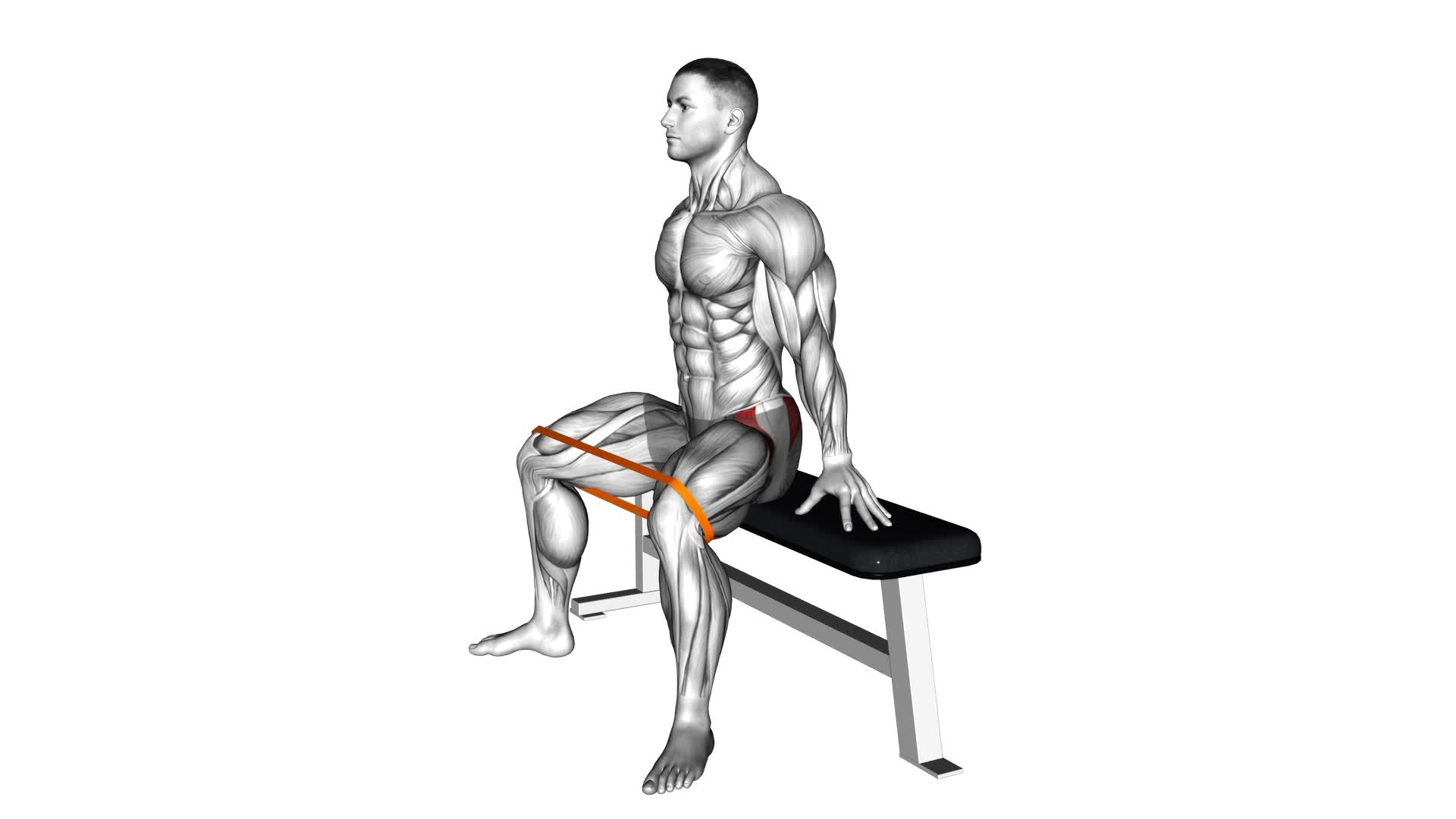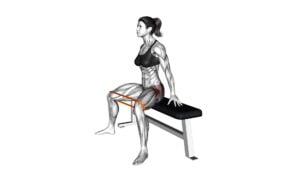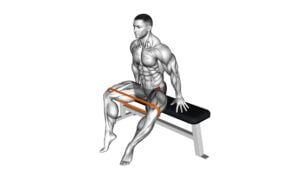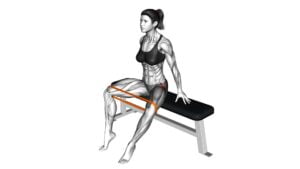Resistance Band Seated Hip Abduction (VERSION 2) – Video Exercise Guide & Tips

Get ready to strengthen your hip muscles with the Resistance Band Seated Hip Abduction (Version 2). This video exercise guide and tips will show you how to properly perform this exercise using a resistance band.
Watch This Exercise Video
You'll learn the benefits, equipment needed, and variations to maximize the effectiveness of your workout. Avoid common mistakes and get the most out of your hip abduction routine.
Let's get started!
Key Takeaways
- Resistance band seated hip abduction increases hip strength and stability.
- It targets hip muscles for improved function and enhances overall fitness and performance in other exercises.
- It helps prevent injuries in the lower back and knees while improving balance, stability, and posture.
- Customization and proper form are important in maximizing the benefits of resistance band seated hip abduction.
Benefits of Resistance Band Seated Hip Abduction
You can experience increased hip strength and stability by incorporating resistance band seated hip abduction into your workout routine. This exercise specifically targets the muscles in your hips, helping to improve their overall strength and function.
The benefits of resistance band seated hip abduction go beyond just your hip muscles. Strong hips are essential for overall fitness and can improve your performance in other exercises, such as squats and lunges. Additionally, having strong hips can help prevent injuries, especially in the lower back and knees.
By regularly performing resistance band seated hip abduction, you can enhance your balance and stability, which is crucial for activities like running, jumping, and even everyday movements. This exercise also engages your core muscles, further assisting in improving your overall stability and posture.
So, if you want to enhance your hip strength and stability while reaping the numerous benefits it offers for your overall fitness, resistance band seated hip abduction is a great addition to your workout routine.
Now, let's discuss the equipment needed for this exercise.
Equipment Needed for the Exercise
To perform resistance band seated hip abduction, you'll need a resistance band and a sturdy chair or bench. Resistance bands are versatile and affordable exercise tools that offer numerous benefits. They provide resistance throughout the entire range of motion, helping to build strength and improve muscle tone. Additionally, resistance bands are portable, making them convenient for home workouts or when traveling.
Apart from seated hip abduction, there are various other resistance band exercises you can incorporate into your workout routine. These include banded squats, banded lateral walks, banded glute bridges, and banded clamshells. Each exercise targets different muscle groups and can be modified to suit your fitness level.
Using a resistance band for seated hip abduction adds resistance to the exercise, challenging your hip abductor muscles even more. This exercise targets the outer thigh muscles, helping to strengthen and tone them. It can also improve hip stability and mobility, which is crucial for everyday movements and athletic performance.
Now that you know the equipment needed for resistance band seated hip abduction and the benefits of using resistance bands, let's move on to the next section where we'll discuss the proper form and technique for this exercise.
Proper Form and Technique
Mastering proper form and technique is essential for maximizing the effectiveness of resistance band seated hip abduction. By maintaining correct form, you can target the muscles in your hips more efficiently, leading to better results. Proper form also helps to prevent injury and ensure that you're getting the most out of your workout.
To perform the resistance band seated hip abduction exercise correctly, start by sitting on a stable surface with your back straight and your feet flat on the ground. Place the resistance band around your thighs, just above your knees. Slowly open your legs apart, pushing against the resistance band while keeping your knees in line with your hips. Pause for a moment at the end of the movement, then slowly return to the starting position.
Remember to engage your core and maintain a neutral spine throughout the exercise. Avoid using momentum or excessive force to perform the movement. Instead, focus on controlled and deliberate movements to activate the muscles in your hips effectively.
Hip abduction benefits include strengthening the muscles in your hips, improving stability, and enhancing overall lower body strength. If you find this exercise too challenging, you can modify it by using a lighter resistance band or performing the movement with your legs bent at a 90-degree angle. Always listen to your body and adjust the exercise as needed to avoid any discomfort or pain.
Variations and Modifications
Now let's explore some alternative abductor exercises that you can incorporate into your resistance band workouts. These variations will help target different muscle groups and add variety to your routine.
Additionally, don't forget that you can customize your resistance band workouts by adjusting the tension of the band or using different types of bands to challenge yourself further.
Alternative Abductor Exercises
You can easily incorporate alternative abductor exercises into your workout routine by frequently incorporating variations and modifications.
There are several hip abduction alternatives that can effectively target your abductor muscles. One option is the side-lying leg lift, where you lie on your side and lift your top leg up towards the ceiling.
Another option is the standing cable hip abduction, where you attach a cable to your ankle and lift your leg out to the side against the resistance.
You can also try the seated hip abduction machine at the gym, which isolates your abductor muscles and allows you to adjust the weight according to your fitness level.
These effective abductor exercises will help strengthen and tone your hips and thighs, improving your overall lower body strength.
Customizing Resistance Band Workouts
To customize resistance band workouts, incorporate variations and modifications that target specific muscle groups, such as the abductor muscles discussed in the previous subtopic. Customizing resistance band exercises allows you to tailor your workouts to your specific fitness goals and needs.
Here are three variations and progressions for resistance band workouts:
- Increase resistance: Use a band with higher tension or add multiple bands to increase the challenge and intensity of your exercises. This will help you build strength and endurance in your target muscles.
- Change body positioning: Alter the position of your body to engage different muscles. For example, performing seated hip abductions with the resistance band can be modified to standing or lying down positions to target different angles of the abductor muscles.
- Combine exercises: Combine different resistance band exercises to create a full-body workout. For example, you can alternate between seated hip abductions and bicep curls to work both your lower body and upper body simultaneously.
Customizing your resistance band workouts not only keeps your routine interesting but also ensures that you're continuously challenging your muscles for optimal results.
Tips for Maximizing the Effectiveness
To maximize the effectiveness of the Resistance Band Seated Hip Abduction exercise, focus on maintaining proper form throughout the movement. This will ensure that you're targeting the right muscles and maximizing results.
Start by sitting on a chair with your back straight and your feet flat on the floor. Place a resistance band around your thighs, just above your knees. Engage your core muscles and keep your pelvis stable throughout the exercise.
To perform the movement, slowly open your legs to the side, pushing against the resistance of the band. Make sure to keep tension on the band at all times and avoid allowing your knees to collapse inward. Aim to feel the outer hip muscles working as you open your legs.
To increase the intensity of the exercise, you can use a band with higher resistance or increase the number of repetitions. Remember to breathe steadily and avoid any jerky movements.
By maintaining proper form and gradually increasing the intensity, you can maximize the effectiveness of the Resistance Band Seated Hip Abduction exercise. This will help you achieve better results in strengthening and toning your hip muscles.
Now, let's move on to the next section and discuss some common mistakes to avoid.
Common Mistakes to Avoid
To maximize the effectiveness of your resistance band seated hip abduction exercise, there are a few common mistakes you should avoid.
First, make sure to maintain proper hip alignment throughout the exercise, keeping your hips parallel to the ground.
Additionally, ensure that the tension in the resistance band is appropriate, not too loose or too tight, to target your hip muscles effectively.
Hip Alignment During Exercise
Ensure Proper Hip Alignment During Exercise to prevent injuries and maximize the effectiveness of your workout. Proper hip alignment is crucial for maintaining stability and preventing strain on the surrounding muscles and joints.
Here are some common hip alignment issues to be aware of:
- Internal rotation: When the hip joints rotate inward, it can lead to imbalances and put stress on the knees and lower back.
- Hip drop: This occurs when one hip drops lower than the other, causing misalignment and potential strain on the hip and pelvic muscles.
- Forward tilt: A forward tilt of the hips can lead to an excessive arch in the lower back, increasing the risk of lower back pain and injury.
Proper Band Tension
When using resistance bands for seated hip abduction exercises, it's important to maintain proper tension throughout the movement to avoid common mistakes and maximize the effectiveness of the exercise.
Proper band tension ensures that you're working your hip muscles effectively and safely. One common mistake to avoid is using a band that's too loose, which can result in ineffective resistance and reduced muscle activation.
On the other hand, using a band that's too tight can lead to improper form and potential injury. To achieve proper tension, choose a band with the appropriate resistance level for your strength and fitness level.
Experiment with different band tensions to find the one that challenges you without compromising your form. Proper band tension is key to getting the most out of your resistance band exercises and effectively strengthening your hips.
Frequently Asked Questions
How Many Sets and Reps Should I Do for Resistance Band Seated Hip Abduction?
For resistance band seated hip abduction, you should aim for 3 sets of 12-15 reps.
This exercise targets your hip muscles, helping to strengthen and tone them.
By using a resistance band, you add an extra challenge to the movement, increasing muscle activation and promoting better overall hip stability.
Performing this exercise regularly can improve your hip strength and flexibility, which can be beneficial for activities like running, squatting, and jumping.
Can Resistance Band Seated Hip Abduction Help With Improving Balance?
Resistance band seated hip abduction is an effective exercise for improving stability and balance. By targeting the hip abductor muscles, this exercise helps strengthen the muscles responsible for maintaining balance.
The resistance band adds an extra challenge, increasing the benefits of the exercise. Incorporating resistance band exercises into your routine can have numerous advantages, such as improving muscle strength and flexibility.
Are There Any Specific Precautions or Contraindications for This Exercise?
Before attempting any exercise, it's important to consider the precautions and contraindications associated with it. Specifically for Resistance Band Seated Hip Abduction, there are certain factors to keep in mind.
It's advisable to consult with a healthcare professional if you have any pre-existing hip or lower back injuries. Additionally, if you experience pain or discomfort during the exercise, it's crucial to stop and seek guidance.
Always prioritize your safety and listen to your body while performing this exercise.
Can Resistance Band Seated Hip Abduction Be Done by People of All Fitness Levels?
Resistance band seated hip abduction is a great exercise for improving hip strength, regardless of your fitness level. By using resistance bands, you can gradually increase the intensity of the exercise as you get stronger.
This exercise targets the muscles in your hips, helping to improve stability and prevent injuries. Resistance band exercises, in general, have many benefits, such as improving muscle tone, increasing flexibility, and enhancing overall strength.
Is Resistance Band Seated Hip Abduction Suitable for Individuals With Hip or Knee Injuries?
For individuals with hip or knee injuries, resistance band seated hip abduction may not be suitable. It's important to modify exercises to accommodate your specific needs and prevent further injury.
Consult with a professional, such as a physical therapist or trainer, who can provide alternatives for injury rehabilitation. They can suggest exercises that target the same muscle groups without putting excessive strain on your hips or knees.
Always prioritize your safety and listen to your body's limitations.
Conclusion
In conclusion, the resistance band seated hip abduction exercise is a beneficial way to strengthen and tone the hip muscles.
By using the correct form and technique, along with variations and modifications, you can maximize the effectiveness of this exercise.
Remember to avoid common mistakes and follow the tips provided to ensure proper execution.
Incorporate this exercise into your routine to improve hip stability and enhance overall lower body strength.

Author
Years ago, the spark of my life’s passion ignited in my mind the moment I stepped into the local gym for the first time. The inaugural bead of perspiration, the initial endeavor, the very first surge of endorphins, and a sense of pride that washed over me post-workout marked the beginning of my deep-seated interest in strength sports, fitness, and sports nutrition. This very curiosity blossomed rapidly into a profound fascination, propelling me to earn a Master’s degree in Physical Education from the Academy of Physical Education in Krakow, followed by a Sports Manager diploma from the Jagiellonian University. My journey of growth led me to gain more specialized qualifications, such as being a certified personal trainer with a focus on sports dietetics, a lifeguard, and an instructor for wellness and corrective gymnastics. Theoretical knowledge paired seamlessly with practical experience, reinforcing my belief that the transformation of individuals under my guidance was also a reflection of my personal growth. This belief holds true even today. Each day, I strive to push the boundaries and explore new realms. These realms gently elevate me to greater heights. The unique combination of passion for my field and the continuous quest for growth fuels my drive to break new ground.



